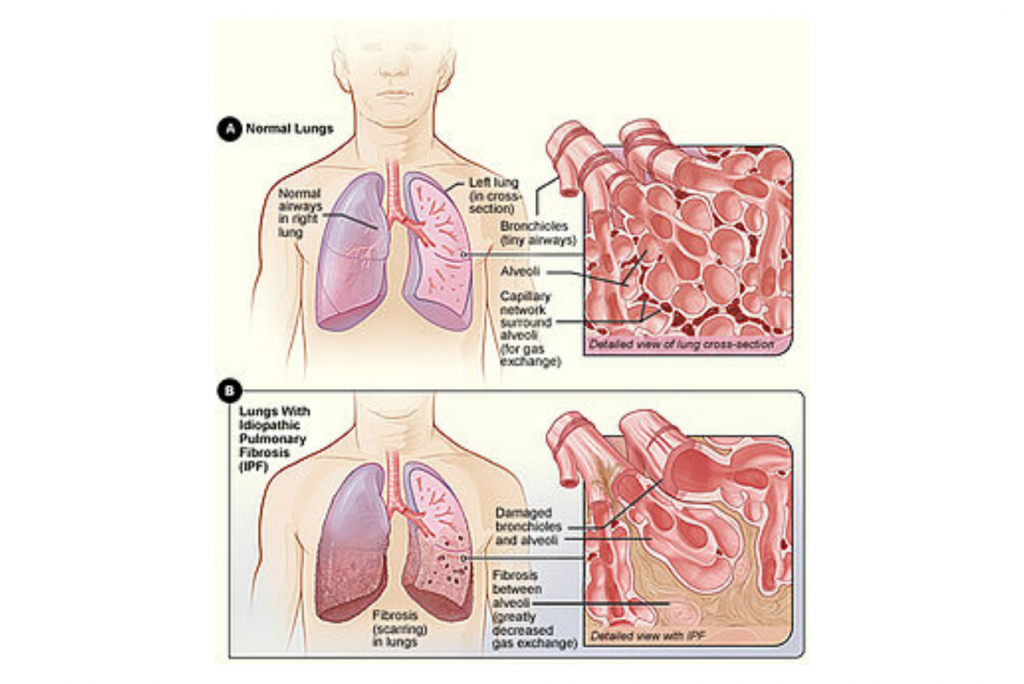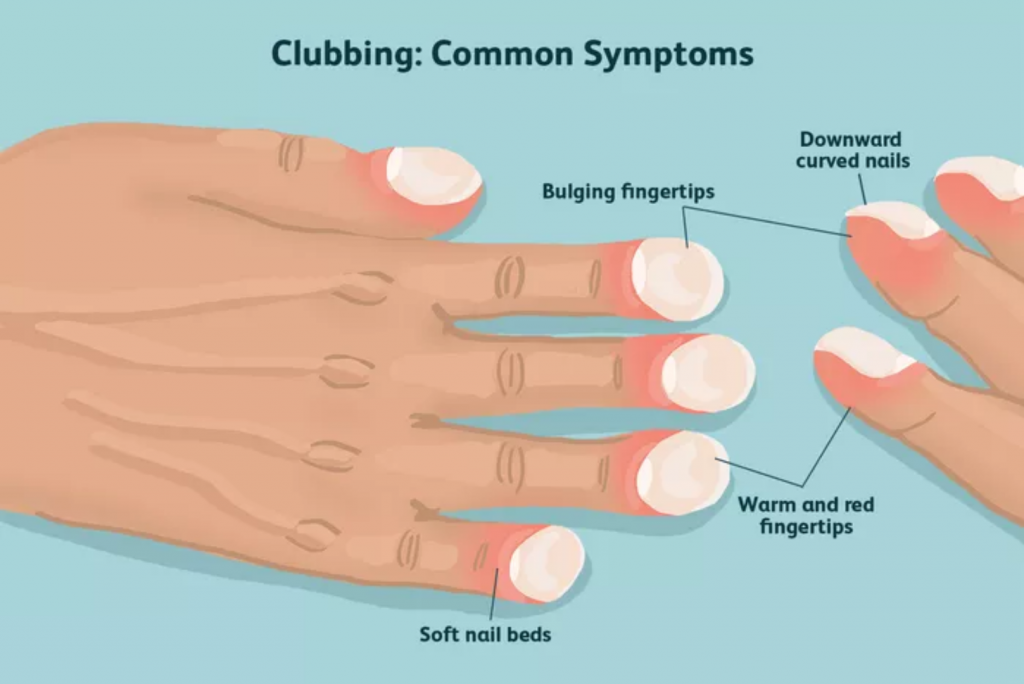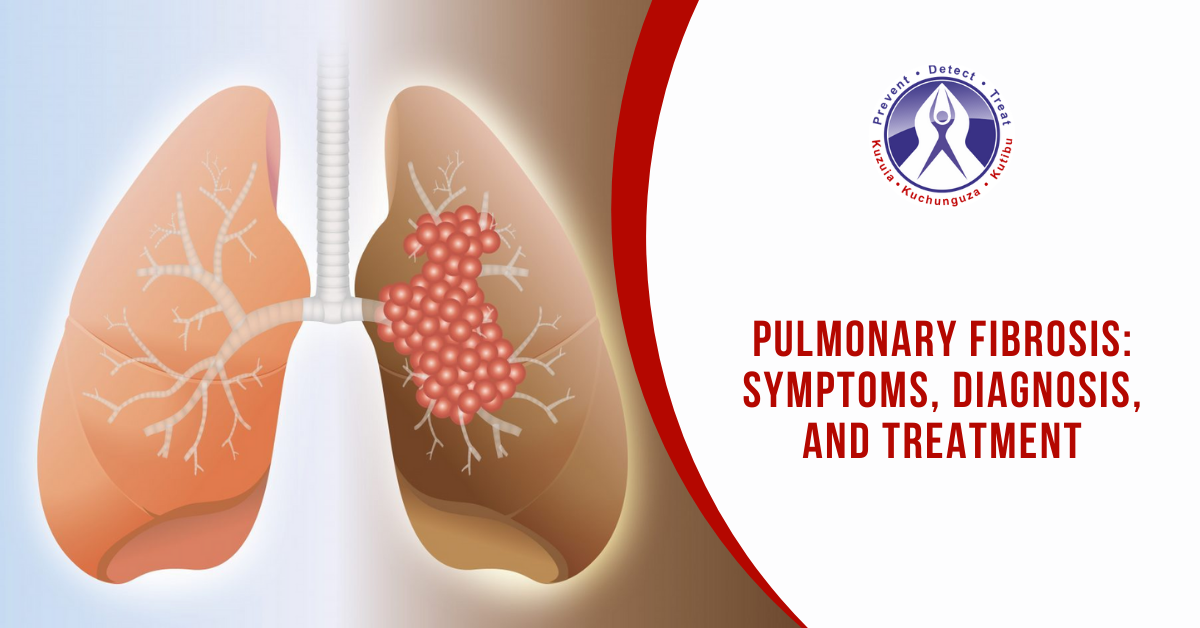Pulmonary Fibrosis: Symptoms, Diagnosis, and Treatment
1,831 viewsThe current pandemic has made people extremely cautious about their lung health. Before COVID-19 made the world be scared of lung disease, there was very little awareness in the general public about pulmonary fibrosis. Pulmonary fibrosis is a serious lung disease that hampers breathing and can cause other complications. The best defence against the disease is to be aware of how it’s caused and how it’s treated. We have compiled everything you need to know about it in this blog. Read on to understand pulmonary fibrosis symptoms, diagnosis, and treatment.
What is pulmonary fibrosis?

Pulmonary refers to “lungs” and fibrosis means “a scar.” Thus, in the language of a layman, pulmonary fibrosis means the scarring of lungs in an individual’s body. This scar can be just like any other scar in the body. It may look like the scars you get after an injury or after surgery. In many cases, pulmonary fibrosis looks like the lungs have a scar as if from a cut.
The term pulmonary fibrosis broadly means the scarring of the lung but it is not a single disease. Pulmonary fibrosis is an umbrella term for many very similar lung diseases that ultimately lead to scarring lung tissue in the patients.
How does pulmonary fibrosis lead to shortness of breath?
Lungs are the body’s major receptor of oxygen. Meaning, when you breathe in, the oxygen directly moves to your lungs. The lungs then transport it to the bloodstream. From there, it travels to the other organs of the body.
When the lungs have caught pulmonary fibrosis, thick scar tissue prevents them from working properly. As a result, the lungs find it hard to let the body breathe. The patient then develops problems of shortness of breath.
The less oxygen the body takes in, the harder it is for the organs to function properly.
What causes pulmonary fibrosis?
As we mentioned earlier, there are many different types of pulmonary fibrosis. Each type has different underlying causes too.
Idiopathic Pulmonary Fibrosis – when there is no known cause of pulmonary fibrosis

Idiopathic pulmonary fibrosis is when there is no particular cause underlying your lung disease. There have been a large number of cases wherein people had been living a normal life for many years with idiopathic pulmonary fibrosis. In such cases, the symptoms start to appear at an advanced stage, mostly between the ages of 50 and 70 years.
Although the doctors can’t attribute this lung disease to a cause, there are many risk factors that may be responsible.
The most common risk factors for idiopathic pulmonary fibrosis are long-term exposure to toxins, environmental pollution, and smoking cigarettes.
Pulmonary fibrosis caused by certain diseases or treatments
For many people, the causes of pulmonary fibrosis are the diseases they have already been fighting. Most of these diseases are autoimmune diseases or viral and more serious infections.
Common diseases that may lead to pulmonary fibrosis are rheumatoid arthritis, systemic lupus erythematosus, scleroderma, and Pneumonia.
Severe cases of pneumonia arising from COVID-19 have also shown signs of pulmonary fibrosis.
Lastly, certain medication and radiation treatments can lead to pulmonary fibrosis in rare cases.
Sometimes, Pulmonary fibrosis can be hereditary
Doctors across the world have encountered many cases where a few people from the same family had been diagnosed with pulmonary fibrosis. This type is called familial pulmonary fibrosis.
In such cases, the cause of pulmonary fibrosis can be some sort of faulty modification in the genes.
If your family has a history of pulmonary fibrosis, you should get your lungs checked at regular intervals.
It’s very important to understand how a patient suffering from pulmonary fibrosis feels. This helps diagnose the disease at the right time. The following sections cover pulmonary fibrosis symptoms, diagnosis, and treatment in detail.
What are the first signs of pulmonary fibrosis?

People suffering from pulmonary fibrosis may notice the first signs of lung problems when they feel out of breath. Shortness of breath may occur even while doing very easy activities like walking or climbing a short staircase.
Other common symptoms of pulmonary fibrosis are:
- A persistent dry cough
- Fatigue even after a lot of rest
- Clubbing (when fingertips broaden and nails become spongy)
- Pain in the chest
- Weight loss
- Pain in joints and muscles
Pulmonary fibrosis mostly occurs in the late 50s or 60s. Most of these cases go undiagnosed in the initial stages because people ignore breathlessness as just a sign of old age.
Whenever you experience shortness of breath, do consult your doctor immediately. Even if it’s not pulmonary fibrosis, it may be a warning sign of other lung diseases.
How is pulmonary fibrosis diagnosed?
Pulmonologists (lung specialist doctors) are approached by people when they have experienced shortness of breath for a few days. Because shortness of breath can be caused by other conditions too, the doctor first conducts a physical examination of the patient.
During the physical examination, the doctor carefully listens to the sounds made by the lungs with the help of a stethoscope. If they hear a crackling sound, they may suggest you undergo imaging tests to confirm whether you have pulmonary fibrosis.
The first test in diagnosing pulmonary fibrosis is a chest x-ray. If the x-ray shows signs of fibrosis in the lungs, your doctor will suggest the course of treatment on the basis of extent of lung damage seen.
If the x-ray doesn’t clearly show the thick scar tissue, your doctor may ask you to do a CT scan of your lungs.
The CT scan shows cross-sectional images of the lungs from various different angles. This helps the doctors accurately examine the lungs for fibrosis.
If the disease is in the initial stage, even the CT scan may not show the scar tissue clearly. In these cases, the doctor may recommend a biopsy.
During a biopsy, expert doctors remove a tiny part of lung tissue by performing a surgery. This tissue is then examined in special biopsy labs to confirm or rule out fibrosis in the lungs.
What is the best treatment for pulmonary fibrosis?
Unfortunately, there is no cure for pulmonary fibrosis. The best treatment for fibrosis in the lungs is about relieving the symptoms and slowing down the disease progression.
Medication for pulmonary fibrosis
Medicines like nintedanib and pirfenidone have been effective in slowing down the progression of fibrosis in the lungs. However, not all patients can consume these medicines due to their heavy side effects.
For pain management and reducing lung inflammation, doctors may often prescribe Corticosteroids too.
Oxygen therapy for pulmonary fibrosis
In severe cases, patients may need to inhale oxygen through prongs or masks. This is essential to maintain the flow of oxygen in the body.
In less severe cases, patients may be required to take oxygen therapy only while sleeping or intense activities like exercising.
Lung transplant
In extremely rare cases, patients may be eligible for a lung transplant. Even if the patient is lucky enough to find a donor, the transplant itself is a very difficult procedure.
After a lung transplant, patients have to take certain medications life long so that the body can function in harmony with the new lung.
Conclusion
Pulmonary fibrosis is a serious disease but fortunately, it occurs mostly in people over 50 years of age. The prognosis of pulmonary fibrosis is not very good as there is no cure for this disease except a lung transplant. However, if you know pulmonary fibrosis symptoms, diagnosis, and treatment options well, you can help yourself or your loved ones manage the disease very effectively. Ultimately, the timely and accurate diagnosis of fibrosis is the major factor contributing to a good quality of life for patients.
Regency Medical Centre strives to help the people of Tanzania seek the best possible treatment for pulmonary fibrosis. Our veteran pulmonologists have a track record of accurate diagnosis and effective supportive treatment for pulmonary fibrosis.
Want to consult our doctors from the safety of your home? Book an online appointment here.


